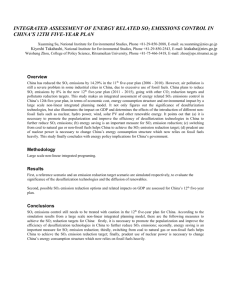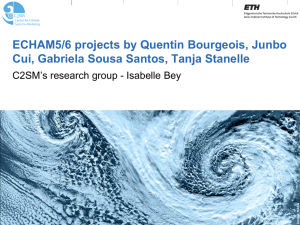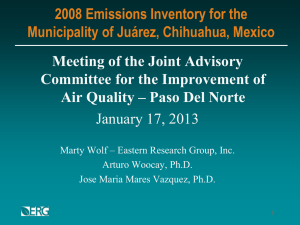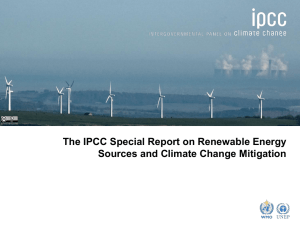An introduction to developing Glocal Century Energy
advertisement
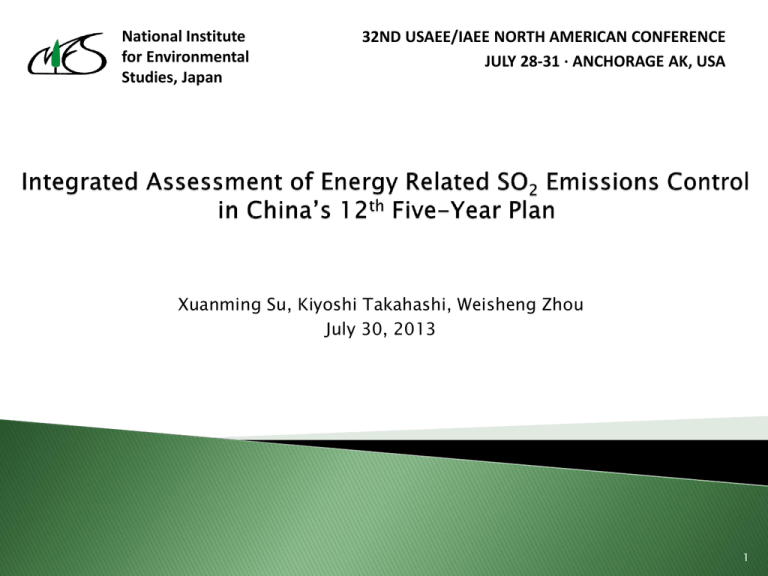
National Institute for Environmental Studies, Japan 32ND USAEE/IAEE NORTH AMERICAN CONFERENCE JULY 28-31 · ANCHORAGE AK, USA Xuanming Su, Kiyoshi Takahashi, Weisheng Zhou July 30, 2013 1 1. Introduction 2. Methodologies 3. Results and Discussion 4. Conclusions References 2 China’s five-year plans are a series of social and economic development initiatives. SO2 reduction targets and results in the previous five-year plans. 10th (2001-2005) 11th (2006-2010) SO2 reduction targets 10% below 2000 levels 10% below 2005 levels SO2 reduction results Industrial emissions meeting discharge standards 27.8% above 2000 levels 14.3% below 2005 levels Industrial desulfurization rate 79.4% 97.9% 33.5% 66.0% Source: NBS & MEP, China statistical yearbook on environment (2000-2012) 3 Industrial desulfurization rate 60.0 Industrial SO₂ removed Household SO₂ emissions Industrial SO₂ emissions 50.0 SO₂ emissions (Mt) 40.0 66.0% 33.5% 30.0 ↑27.8% ↓14.3% 20.0 10.0 0.0 1992 1994 1996 1998 2000 2002 2004 2006 2008 2010 SO2 emissions of China (1992-2010) Source: NBS, China statistical yearbook (1990-2012), NBS & MEP, China statistical yearbook on environment (1998-2012) 4 5 SO₂ emissions removed (left) SO₂ emissions (left) Desulfurization rate (right) 100% Mean desulfurization rate (right) Above mean desulfurization rate 90% 77.2% 4 SO₂ emissions and removed (Mt) 76.9% 68.3% 69.6% 63.2% 3 63.2% 77.6% 69.5% 66% 61.5% 59.5% 61.2% 60.1% 57.3% 55.2% 50.9% 2 70% 67.9% 66.5% 62.9% 80% 79.3% 77.1% 75.7% 62.7% 65.4% 60.4% 60% 53.7% 50% 48.1% 40.3% 40% 30% 25.7% 1 20.9% 17.3% 20% 10% 0 0.0% 0% SO2 emissions and desulfurization rates by provinces of China in 2010 Source: NBS, China statistical yearbook (2011) 5 Mining & Quarrying 2.0% Other Industries 0.1% Household 15.8% Food, Beverage & Leather, Furs & Tobacco Down Papermaking & Textile 2.0% 0.3% Paper Products 1.2% 2.5% Printing & Record Medium 0.0% Petroleum, Coking & Nuclear Fuel Chemical Materials 3.1% & Products 5.1% Medical & Pharmaceutical 0.4% Rubber Chemical Fiber 0.2% 0.5% Plastic Nonmetal Mineral 8.3% 0.1% Ferrous Metals 8.7% Electric & Heat Power 44.5% Nonferrous Metals 4.0% Metal Products 0.2% Machine & Electronic Equipment 0.8% SO2 emissions by sectors of China in 2010 Source: NBS, China statistical yearbook (2011) 6 Above mean desulfurization rate 100% 89.9% Mean desulfurization rate 79.0% 80% 63.9% 68.3% 66.0% 61.8% 60% 54.2% 48.3% 40% 20% 31.4% 28.7% 31.3% 18.1% 15.0% 34.9% 47.5% 31.7% 34.3% 31.9% 19.4% 23.5% 0% Industrial desulfurization rates by sectors of China in 2010 Source: NBS, China statistical yearbook (2011) 7 • • SO2 emissions limit in 2015: 20.9 Mt, 8% below 2010 levels. 0.2 Mt is reserved for SO2 emission trading pilot projects among regions and enterprises. 3 provinces are allowed to increase SO2 emissions. China’s SO2 emission reduction target in the 12th Five-Year Plan Source: State Council of China, The Comprehensive Work Plan for Energy Conservation and Emission Reduction During the 12th Five-Year Plan Period 8 Two-level CES production function 1 Macroeconomic constraints K: Capital stock Y: Production output 2 Energy balance Expansion factor prv: Reserve ratio E: Electricity PE: Electricity supply RSV: Proved reserves N: Non electricity PN: Non-electricity supply ENTRD: Energy import/export L: Labor YN = F(KN, LN, EN, NN) EMF: Emission factor Learning rate INV: Investment NENC: Nonenergy carbon Y = CON + INV + EC CON: Consumption EC: Energy cost Carbon Emission CARLIM: Carbon limits UDF: Utilility disounted factor UTIL: Discounted utility maximize Technological learning CTAX: Carbon tax CARTRD: Carbon import/export 3 Emission evaluation Integrated assessment model framework 9 SO2 emission calculation SO2r 2Qrse Sre re (1 re ) s e ◦ SO2r: SO2 emissions in specific region. ◦ Qrse: Energy thermal consumptions in specific region, sector and energy source. ◦ Sre: Sulfur content in specific region and energy source. ◦ αre: SO2 emission factor in specific region and energy source. ◦ δre: Desulfurization rate in specific region and energy source. Objective function 5 t 1 UTIL 5 j 0 (1 udrj , r ) log(Ct , r ) r 1 t 1 R T ◦ UTIL: Discounted consumption. ◦ C: Annual consumption. ◦ udr: Utility discount rate. 10 Four GDP growth scenarios ◦ planned growth 12th Five-Year Plan: 7% ◦ GDP growth scenarios: 5%, 7%, 9% and 11% Five possible desulfurization rates ◦ desulfurization rate in 2010: 66.0% ◦ desulfurization rate scenarios: 50%, 60% 70%, 80% and 90% ◦ given exogenously due to the uncertainty of the popularizing rates of desulfurization equipment All the scenarios are simulated: ◦ in view of China’s current economic development and energy consumption ◦ considering relevant environmental protection and greenhouse gas emission reduction 11 SO2 emission scenarios of China in 2015 GDP growth Scenarios 5% (%) Primary energy consumption 2673 (Mtoe) Electricity generation 5306 (TWh) Gross SO2 emissions 60.6 7% 2818 5893 65.0 9% 3001 6434 69.0 11% 3405 8193 80.7 (Mt) Household SO2 emissions (Mt) 2.1 2.2 2.2 2.3 7% growth scenario reduces 14.0% of energy consumption per unit of GDP, slightly lower than the target of 16% set in the 12th Five-Year Plan. The household SO2 emissions show little change due to the single emission source, namely the direct use of coal. SO2 emitted by household use of petroleum gas/natural gas is ignored in this study. 12 40 5% growth 30 SO₂ emissions (Mt) SO₂ emissions (Mt) 30 20 10 20 10 0 0 2010 SO₂ emissions 50% 60% 70% 80% 90% 2010 Scenarios with different industrial desulfurization rate 50% SO₂ emissions 60% 9% growth SO₂ emissions (Mt) 20 10 80% 90% 11% growth 40 30 70% Scenarios with different industrial desulfurization rate 50 40 SO₂ emissions (Mt) 7% growth 40 30 20 10 0 0 2010 SO₂ emissions 50% 60% 70% 80% Scenarios with different industrial desulfurization rate 90% 2010 50% SO₂ emissions 60% 70% 80% 90% Scenarios with different industrial desulfurization rate SO2 emission reduction scenarios 13 Industrial desulfurization rate needed for 12th 5-year plan targets (%) 100% 80% Desulfurization rates should be raised above 70% due to the uncertainty of GDP growth. The popularization of wet-type SO2 scrubbers and improvement of the environmental emission standards play an important role in the achievement of SO2 control target by 2015 77.8% 73.8% 72.1% 69.9% 63.9% 60% 40% 33.5% 20% 0% 2005 2010 5% 7% 9% 11% GDP growth scenarios Industrial desulfurization rate needed for 12th 5-year plan targets 14 Emissions by other sectors (Left) SO₂ emissions by power generation 4 Emission intensity of power generation (Right) 40 SO₂ emissions (Mt) 3 30 2 20 1 10 0 SO₂ emission intensity of power generation (g/kWh) 50 0 2010 50% 60% 70% 80% 90% 50% 60% 70% 80% 90% 50% 60% 70% 80% 90% 50% 60% 70% 80% 90% GDP growth 5% GDP growth 7% GDP growth 9% GDP growth 11% SO2 emissions by power generation and other sectors, and SO2 emissions intensity of power generation 15 This study makes a comprehensive assessment of energy related SO2 emissions control in China’s 12th Five-Year Plan based on a large scale non-linear integrated assessment model. 1. There is a relative large potential for China to reduce SO2 emissions technologically and the popularization of wet-type SO2 scrubbers and improvement of the environmental emission standards play an important role in the achievement of SO2 control target by 2015. 2. The improvement in energy consumption structure contributes to SO2 and other energy related emission controls effectively, as well as the sustainable development of energy. 3. The thresholds of desulfurization for different growth scenarios, namely 5%, 7%, 9% and 11% scenarios, to achieve the SO2 emission control target are presented in this study, as 69.9%, 72.1%, 73.8% and 77.8, respectively. 4. Future environmental policy should concentrate on the provinces which emit SO2 seriously, like Shandong, Inner Mongolia and Henan, or relevant industrial sectors such as electric & heat power, ferrous metals and nonmetal mineral sectors. 16 BP (2013), "BP Statistical Review of World Energy", June, 2013. BP Publishing. IEA (2012), "Energy Balances of non-OECD Countries 2012 Edition" OECD Publishing. Kanada, M., Dong, L., Fujita, T., Fujii, M., Inoue, T., Hirano, Y., Togawa, T., et al. (2013). Regional disparity and cost-effective SO2 pollution control in China: A case study in 5 mega-cities. Energy Policy, (In Press). doi:http://dx.doi.org/10.1016/j.enpol.2013.05.105 Kaneko S, Fujii H, Sawazu N and Fujikura R (2010), "Financial allocation strategy for the regional pollution abatement cost of reducing sulfur dioxide emissions in the thermal power sector in China", Energy Policy. Vol. 38(5), pp. 2131 - 2141. Lin B, Jiang Z and Zhang P (2011), "Allocation of sulphur dioxide allowance – An analysis based on a survey of power plants in Fujian province in China ", Energy. Vol. 36(5), pp. 3120 - 3129. Lin W, Xu X, Ma Z, Zhao H, Liu X and Wang Y (2012), "Characteristics and recent trends of sulfur dioxide at urban, rural, and background sites in North China: Effectiveness of control measures", Journal of Environmental Sciences. Vol. 24(1), pp. 34 - 49. Lu Z, Streets DG, Zhang Q, Wang S, Carmichael GR, Cheng YF, Wei C, Chin M, Diehl T and Tan Q (2010), "Sulfur dioxide emissions in China and sulfur trends in East Asia since 2000", Atmospheric Chemistry and Physics. Vol. 10(13), pp. 6311-6331. MEP (2003), Emission standard of air pollutants for thermal power plants (GB 13223-2003), Beijing: China Environmental Science Press. MEP (2011), Emission standard of air pollutants for thermal power plants (GB 13223-2011), Beijing: China Environmental Science Press. NBS, China Statistical Yearbook (1990-2012), China Statistics Press. NBS & MEP, China statistical yearbook on environment (1998-2012), China Statistics Press. SCC (State Council of China), (2011), The Comprehensive Work Plan for Energy Conservation and Emission Reduction During the 12th Five-Year Plan Period. Schreifels JJ, Fu Y and Wilson EJ (2012), "Sulfur dioxide control in China: policy evolution during the 10th and 11th Five-Year Plans and lessons for the future", Energy Policy. Vol. 48(0), pp. 779 - 789. Su, X., Zhou, W., Nakagami, K., Ren, H., & Mu, H. (2012). Capital stock-labor-energy substitution and production efficiency study for China. Energy Economics, 34(4), 1208–1213. doi:10.1016/j.eneco.2011.11.002. US EPA (2003). Air Pollution Technology Fact Sheet, Flue Gas Desulfurization (FGD) - Wet, Spray Dry, and Dry Scrubbers. EPA-452/F-03-034. United States Environmental Protection Agency. http://www.epa.gov/ttncatc1/products.html#aptecfacts [Accessed June 1, 2013]. Wang X, Liu H, Pang J, Carmichael G, He K, Fan Q, Zhong L, Wu Z and Zhang J (2013), "Reductions in sulfur pollution in the Pearl River Delta region, China: Assessing the effectiveness of emission controls", Atmospheric Environment. Vol. 76, pp. 113 - 124. Xu, Y. (2011). Improvements in the Operation of SO2 Scrubbers in China’s Coal Power Plants. Environmental Science & Technology, 45(2), 380–385. doi:10.1021/es1025678. Zhao B, Wang S, Wang J, Fu JS, Liu T, Xu J, Fu X and Hao J (2013), "Impact of national NOx and SO2 control policies on particulate matter pollution in China ", Atmospheric Environment . Vol. 77(0), pp. 453 - 463. 17 18
